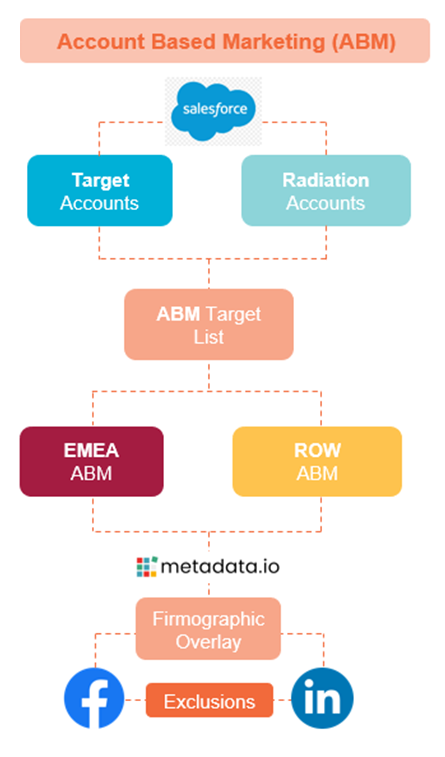
![]() Insights
Insights
When it comes to B2B marketing, getting in front of the right audience is tricky. Often, B2B sales will have multiple decision-makers involved, as purchases can affect multiple areas within a company who may have different priorities.
There is also the issue that, while all B2B decision-makers are people, not all people are B2B decision-makers – so targeting wider populations based on certain demographics like you would in B2C marketing can often be a waste of budget.
Account-based marketing (ABM) is a highly targeted approach, which focuses marketing efforts at winning specific accounts. It involves the close alignment of sales and marketing to define the ideal customer profile (ICP) and identify which accounts are desirable, as well as who in the account you should be nurturing, what the messaging is, and when the sales team should reach out to them.
This data is then used to inform the marketing strategy – everything from the channels used, to the content created, through to the ads served, and even where these ads are placed, should entice and provide value to these prospects.
As accounts move through the sales funnel, the sales team can then work on nurturing and converting these leads, as well as relationship management once the account has been won.
Account-based marketing has several benefits, from the alignment of sales and marketing through to a shorter sales cycle.
It is often dubbed ‘zero waste marketing’ as the resources created are focused on winning specific accounts and are therefore highly personalized, which leads to a higher conversion rate and ultimately ROI. This level of personalization also leads to a better customer journey and, once the account has been won, higher customer satisfaction.
Traditionally, account-based marketing was conducted using a one on one approach; the sales and marketing team would identify which accounts they wanted, and the sales team would get in touch and nurture and win the account this way.
ABM lite, or one to few accounts, involves targeting a selection of accounts which share similar pain points and have similar decision makers/ personas, and programmatic account-based marketing which can be used to target large numbers of accounts which share common traits.
Your digital marketing strategy can be used to support all ABM strategies, both by providing valuable content to these accounts and by helping to reach them. Once accounts have been nurtured through the sales funnel via your digital marketing activity, the sales team can build a one on one relationship with them.
A huge part of account-based marketing is knowing everything about your target accounts – who they are, what they need, where they go for information, what their pain points are… This information can be used to create personalized thought leadership strategies which gets the right message in front of the right accounts.
Your content strategy should consist of pillars or themes which tie back to different personas or account types. This allows you to product content which highlights how your business can alleviate problems the target accounts have without being too broad.
This is the same with PR; once you know which publications your target accounts read, you can create tiered lists of publications to get thought leadership content into, as well as what message you want for which publication.
Account-based marketing relies on the sales team having account details, so ensuring that your content strategy can generate leads is important in being able to feed data back to the sales team. Downloadable whitepapers, webinars, reports, playbooks, etc., are a great way of getting more data for your target accounts.
Paid media can be used to reach your target accounts with the right messaging. How granular you can go depends on the ad platform you choose – for example, Microsoft and LinkedIn’s partnership means that Microsoft Ads can be targeted towards job function, industry and even company list, which means you can get your ads in front of the relevant job levels at your target companies.
Both Facebook and LinkedIn also offer the ability to target specific companies. Layering this with firmographic inclusions and exclusions, such as job level, can narrow down the audience pool and ensure you get in front of the right prospects. Both Facebook and LinkedIn also offer lead extension forms that allow you to capture leads from within the ads, rather than sending a user to the website where they are less likely to convert.
While Google Ads does not offer the ability to target by company, audience targeting can be layered together to create granular audiences which reflect your target accounts, with relevant targeting options including the size of the corporation, industry worked in, and whether they are in-market to buy.
Another option is Google Ads’ customer match, which allows you to upload CRM data and remarket to your customers, as well as find similar audiences to target. This is a useful option if you have captured customer data through your paid social lead generation activity as you are able to remarket to them across the Google Display Network.

Example of ABM paid social targeting
Customized landing pages are a great way of delivering a personalized experience to your target accounts, and by providing relevant content and CTAs you can help to push them along the sales funnel. Examples of customization include changing the case studies shown to be more relevant to the account’s goals or industry and changing the forms for capturing leads to reflect where they are in the journey.
There are several tools available that specialize in conversion rate optimization and website personalization for B2B account-based marketing. For Optimize 360 users who have created custom analytics audiences using their CRM data, these audiences can be published to Optimize 360 and targeted with personalized experiences.
Integrating your account-based marketing and digital strategy helps to nurture target accounts through the sales funnel and drive these leads to the sales team by delivering a more personalized experience across the full customer journey.
This blog is part of our wider B2B Playbook that is designed to help B2B businesses with all aspects of their digital marketing from leveraging data, acquiring more traffic, creating assets that resonate and succeeding internationally.
In the traffic section. we take a look at your paid search and organic methods to grow your reach to get the right traffic to turn into more conversions.
We can deliver an integrated strategy for your B2B businessFind out more

![]() Insights
Insights

![]() Insights
Insights

![]() Insights
Insights